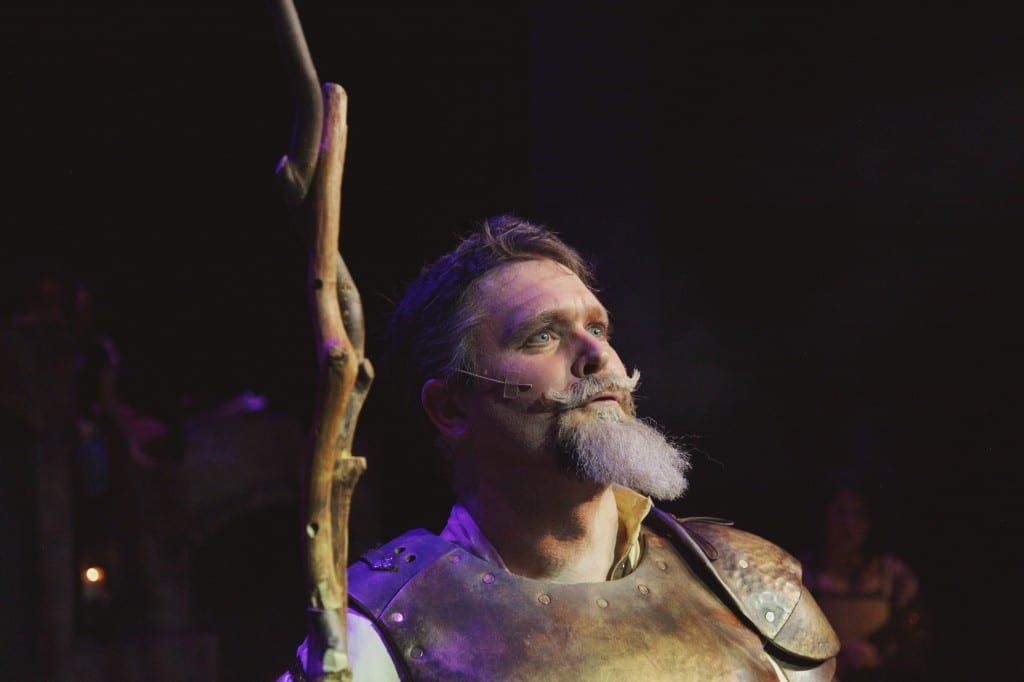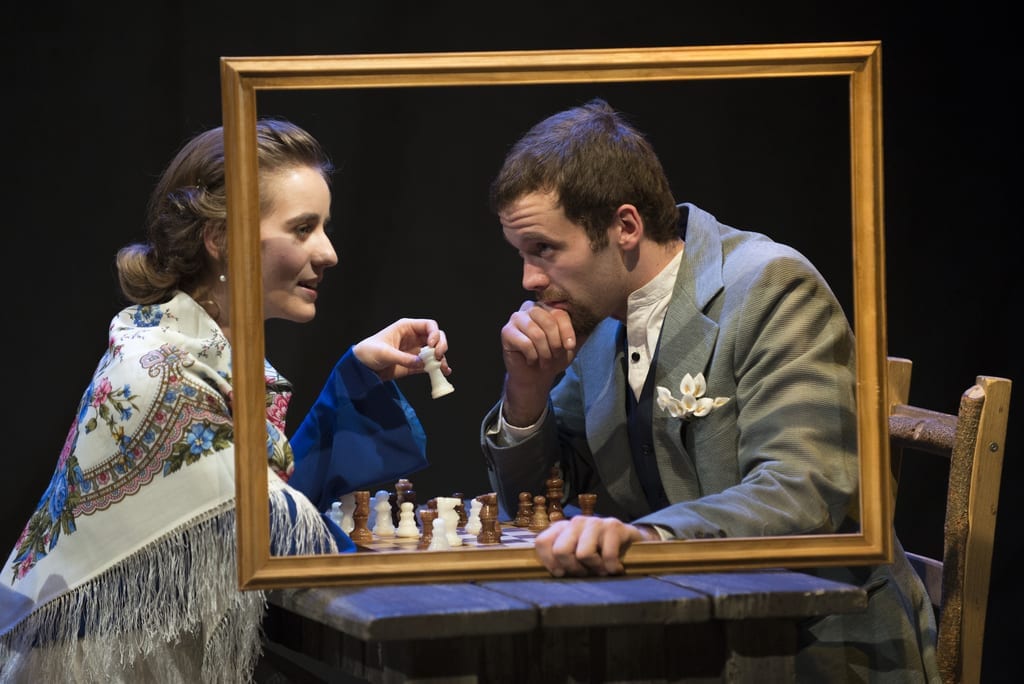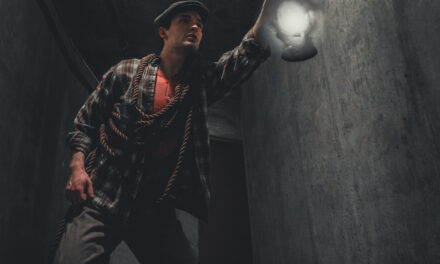CENTERVILLE — Overflowing with iconic songs and the transcendent themes of love, valor, and imagination, it is little wonder that Dale Wasserman‘s Man of La Mancha has kept audiences entertained for nearly forty years. While Joe Darion and Mitch Leigh get credit for its catchy numbers including “The Impossible Dream,” and the title number “Man of La Mancha,” the original story detailing the adventures of the knight Don Quixote began over 400 years ago when Miguel de Cervantes wrote himself into his own tale within a tale.
In Man of La Mancha Cervantes, in prison awaiting trial by the Spanish Inquisition, uses his storytelling skills and the participation of his prisonmates to share the story of Don Quixote, a seemingly delusional man who sees castles where others see rundown inns. Where others see filth, Don Quixote sees beauty, and with the faithful assistance of his squire Sancho Panza, Don Quixote even finds his Dulcinea, the woman to whom he dedicates his quest. However, not everyone is as supportive as Sancho, and Don Quixote eventually leaves a world too harsh for such a dreamer.
Having seen Man of La Mancha before at venues smaller than Centerpoint Legacy Theatre’s Barlow Main Stage, I eagerly anticipated the pomp I was certain awaited me when the curtain rose. The epic proportions of this telling did not disappoint as small details of the set became impressive focal points. Scott VanDyke and Jay Clark, Jr. designed a set that included an operational rescinding bridge, a heating grate that emitted a steady cloud of steam throughout the entire production, a built in basin of water into which an actor was pushed, and a wide variety of stairs and levels which allowed the cast to remain visible on stage without becoming a distraction to the main scenes. The combination of these visual elements with lighting (Mark Rencher) and sound (Clark) produced stunning effects throughout.
 Under the music direction of Emily Wadley, the cast’s vocal talent easily matched the visual spectacle. One early highlight was the first time Monte Garcia opened his mouth to sing as Sancho. His clear tenor offered a surprising contrast to his occasionally whiny portrayal of the loyal squire. Later, Pedro (Hayden Johnson) and the Muleteers (Michael Nielsen, Garrett Ashby, Andy Harrison, Rob Child, and Todd Wente) delivered beautifully balanced harmonies in “Little Bird, Little Bird.” I was also impressed as each of the soloists, specifically including Aldonza (Adrien Swenson) and the Innkeeper (DRU), made the atypical rhythmic patterns in songs like “What Does He Want of Me” and “Knight of the Woeful Countenance” sound natural.
Under the music direction of Emily Wadley, the cast’s vocal talent easily matched the visual spectacle. One early highlight was the first time Monte Garcia opened his mouth to sing as Sancho. His clear tenor offered a surprising contrast to his occasionally whiny portrayal of the loyal squire. Later, Pedro (Hayden Johnson) and the Muleteers (Michael Nielsen, Garrett Ashby, Andy Harrison, Rob Child, and Todd Wente) delivered beautifully balanced harmonies in “Little Bird, Little Bird.” I was also impressed as each of the soloists, specifically including Aldonza (Adrien Swenson) and the Innkeeper (DRU), made the atypical rhythmic patterns in songs like “What Does He Want of Me” and “Knight of the Woeful Countenance” sound natural.
The directing team of Jennie and Josh Richardson created several big moments throughout the production. Each of the Cervantes/Don Quixote (Rhett Richins) solos was staged in a manner that allowed Richins to connect emotionally to the score’s lyrics. “I, Don Quixote,” and “The Impossible Dream” were both filled with the passion and enthusiasm I expected to hear. Thankfully, the show’s talent ran deeper than just the title role, and other big moments were shared by less familiar characters. Allisha Larsen as the Housekeeper delivered a strong alto sound as she added physical humor and complete commitment to “I’m Only Thinking of Him.” Later in the production, Johnson repeatedly cracked a whip convincingly near Aldonza’s back and had me at the edge of my seat. No sound effect could have created the same palpable tension as the sound of an actual whip. Finally, the most memorable moment of the show came through Kati Paul (as Lucia) as she screamed after her brother was taken to be tried by the Inquisition. While credit for the scream belongs to Paul, credit for the powerful aftermath of silence belongs to the two directors.
 While I enjoyed the big moments, I had an even greater appreciation for some of the smaller ones. The show’s early costuming (Jennie Richardson) included accessories that could be easily added to existing costumes to transform the prisoners into characters in Don Quixote’s adventure. I enjoyed watching as characters donned the items handed them and stepped into the tale. Similarly, Cristof (played by Issac Wente) became a windmill simply by moving extended flagpoles in a circular motion. These elements helped me buy into the idea of the tale within the tale. Additionally, when Garcia relaxed into Sancho’s comedic lines, I couldn’t help but laugh. My favorite was when he quietly impersonated Don Quixote while reading “The Missive” to Aldonza. Surprisingly, with so much noise and spectacle, it was another quiet moment that remained with me after I left the theater. After an intense scene in which Aldonza is beaten and whipped, the Duke (Scott VanDyke) stood and began a slow, deliberate applause. The silent space between each clap was absolutely chilling.
While I enjoyed the big moments, I had an even greater appreciation for some of the smaller ones. The show’s early costuming (Jennie Richardson) included accessories that could be easily added to existing costumes to transform the prisoners into characters in Don Quixote’s adventure. I enjoyed watching as characters donned the items handed them and stepped into the tale. Similarly, Cristof (played by Issac Wente) became a windmill simply by moving extended flagpoles in a circular motion. These elements helped me buy into the idea of the tale within the tale. Additionally, when Garcia relaxed into Sancho’s comedic lines, I couldn’t help but laugh. My favorite was when he quietly impersonated Don Quixote while reading “The Missive” to Aldonza. Surprisingly, with so much noise and spectacle, it was another quiet moment that remained with me after I left the theater. After an intense scene in which Aldonza is beaten and whipped, the Duke (Scott VanDyke) stood and began a slow, deliberate applause. The silent space between each clap was absolutely chilling.
 Against a backdrop of so many expertly executed moments, large and small, a few areas seemed glaringly out of place. While I enjoyed the early costumes, each chapter of Don Quixote’s tale seemed to require increasingly involved costuming. At times, the dancers were visibly prepared for a scene in advance, which didn’t fit Cervantes’s style of storytelling. After the gypsies had left the stage late in Act II, the costumes had progressed so much that they involved a complete change of costume into patterned jester’s tights. This clear break from simply adding an accessory distracted more than added value to the production.
Against a backdrop of so many expertly executed moments, large and small, a few areas seemed glaringly out of place. While I enjoyed the early costumes, each chapter of Don Quixote’s tale seemed to require increasingly involved costuming. At times, the dancers were visibly prepared for a scene in advance, which didn’t fit Cervantes’s style of storytelling. After the gypsies had left the stage late in Act II, the costumes had progressed so much that they involved a complete change of costume into patterned jester’s tights. This clear break from simply adding an accessory distracted more than added value to the production.
Having seen Garcia deliver easy moments as Sancho left me wishing for a less over-the-top delivery during so many other parts of the play. Between Sancho and Cervantes/Don Quixote, the show rarely provided a quiet moment. The Cervantes/Don Quixote scenes and songs were delivered with such force that I occasionally felt beaten down, as though I had been yelled at. The constant volume required of Richins may have contributed to marginally out-of-tune ending notes in both “The Impossible Dream,” and “Man of La Mancha (Reprise).” In both cases, he brought the note into perfect tune by the end, but it seemed to come only after fighting through his thick vibrato. Throughout the ups and downs, only one character seemed to strike the perfect balance. As Aldonza, Swenson was just the right blend of grit and heart. While I heard the adventures through Cervantes and considered the philosophies through Don Quixote, I felt the story through Aldonza.
For me, the success of this type of production has to be based in part on its ability to inspire the audience. In this way, despite all its bigness and grandeur, and all its spectacle and aplomb, this production of Man of La Mancha somehow fell just short of being a truly powerful show. While I thoroughly enjoyed my evening in the audience, I left without a renewed desire to “Dream the Impossible Dream.”






